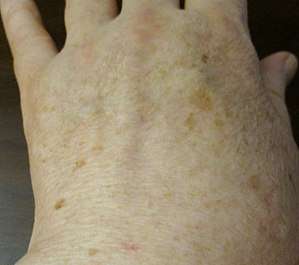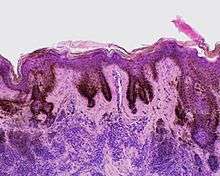Liver spot
Liver spots (also known as age spot, solar lentigo,[1] "lentigo senilis",[1]:686 "old age spot",[2] "senile freckle"[2]) are blemishes on the skin associated with aging and exposure to ultraviolet radiation from the sun. They range in color from light brown to red or black and are located in areas most often exposed to the sun, particularly the hands, face, shoulders, arms and forehead, and the scalp if bald.
| Liver spot | |
|---|---|
 | |
| Liver spots (solar lentigo) on the left hand of a 63-year-old light-skinned Caucasian man | |
| Specialty | Dermatology |
The spots derive their name from the fact that they were once incorrectly believed to be caused by liver problems, but they are physiologically unrelated to the liver, save for a similar colour.[3] From the age of 40 onward the skin is less able to regenerate from sun exposure, and liver spots are very common in this age group, particularly in those who spend time in the sun.
In the overwhelming majority of cases, liver spots pose no threat and require no treatment, though they occasionally have been known to obscure the detection of skin cancer. However, despite being a benign condition, liver spots are sometimes considered unsightly and some people choose to have them removed. This can be done by electrosurgery, laser treatment, cryotherapy, or the use of depigmentation agents, such as hydroquinone,[4] tretinoin,[4] topical cysteamine,[5] azelaic acid,[6] or alpha hydroxy acids.[7]
Causes

Differently from the melanotic nevi and the verrucous nevi on the skin, age spots change in color and in shape with time. Misrepair-accumulation aging theory[8][9] proposes a hypothesis on the development of age spots.[10] Firstly, the development of a flat spot is a result of accumulation of aged basal cells. When the skin is aged, some aged cells that contain lipofuscin bodies cannot be removed. An aged cell will affect the functionality of the local tissue and promote the aging of its neighbor cells. By a feedback loop, more and more neighbor cells become aged and lipofuscin-containing. They aggregate and form a spot with an irregular shape. Secondly, protruding of a flat spot is a result of the death of aged cells in the spot and release of lipofuscin bodies. Isolation of the un-digestible lipofuscin bodies in a fibrotic capsule is essential for maintaining the structural integrity of the tissue. Successive encapsulation of dead cells and lipofuscin bodies results in the growth of a spot in three dimensions. The dense lipofuscin bodies in the capsule make a protruding spot soft and dark in color.
Diagnosis
The diagnosis is usually done by a dermatologist.
See also
References
- James, William D.; Berger, Timothy G.; et al. (2006). Andrews' Diseases of the Skin: Clinical Dermatology. Saunders Elsevier. ISBN 0-7216-2921-0.
- Rapini, Ronald P.; Bolognia, Jean L.; Jorizzo, Joseph L. (2007). Dermatology: 2-Volume Set. St. Louis: Mosby. pp. 1716–17. ISBN 1-4160-2999-0.
- Karen J. Carlson, Stephanie A. Eisenstat, Terra Diane Ziporyn, The new Harvard guide to women's health, Harvard University Press, 2004, p. 337.
- "Age spots (liver spots) Treatments and drugs". Mayo Clinic. Retrieved 2017-02-12.
- Mansouri, P.; Farshi, S.; Hashemi, Z.; Kasraee, B. (2015-07-01). "Evaluation of the efficacy of cysteamine 5% cream in the treatment of epidermal melasma: a randomized double-blind placebo-controlled trial". The British Journal of Dermatology. 173 (1): 209–17. doi:10.1111/bjd.13424. ISSN 1365-2133. PMID 25251767.
- Rodríguez Prieto, M. A.; Manchado Lopez, P.; Ruiz Gonzalez, I.; Suarez, D. (1993-05-01). "Treatment of lentigo maligna with azelaic acid". International Journal of Dermatology. 32 (5): 363–64. doi:10.1111/j.1365-4362.1993.tb01475.x. ISSN 0011-9059. PMID 8505164.
- "Overview about liver spots/age spots". Beauty Natural Skin. Retrieved 3 July 2015.
- Wang, Jicun; Michelitsch, Thomas; Wunderlin, Arne; Mahadeva, Ravi (2009). "Aging as a consequence of Misrepair – a novel theory of aging". 0904: 9. arXiv:0904.0575. Bibcode:2009arXiv0904.0575W. Cite journal requires
|journal=(help) - Wang-Michelitsch, Jicun; Michelitsch, Thomas (2015). "Aging as a process of accumulation of Misrepairs". 1503: 13. arXiv:1503.07163. Bibcode:2015arXiv150307163W. Cite journal requires
|journal=(help) - Wang-Michelitsch, Jicun; Michelitsch, Thomas (2015). "Development of age spots as a result of accumulation of aged cells in aged skin". 1505: 9. arXiv:1505.07012. Bibcode:2015arXiv150507012W. Cite journal requires
|journal=(help)